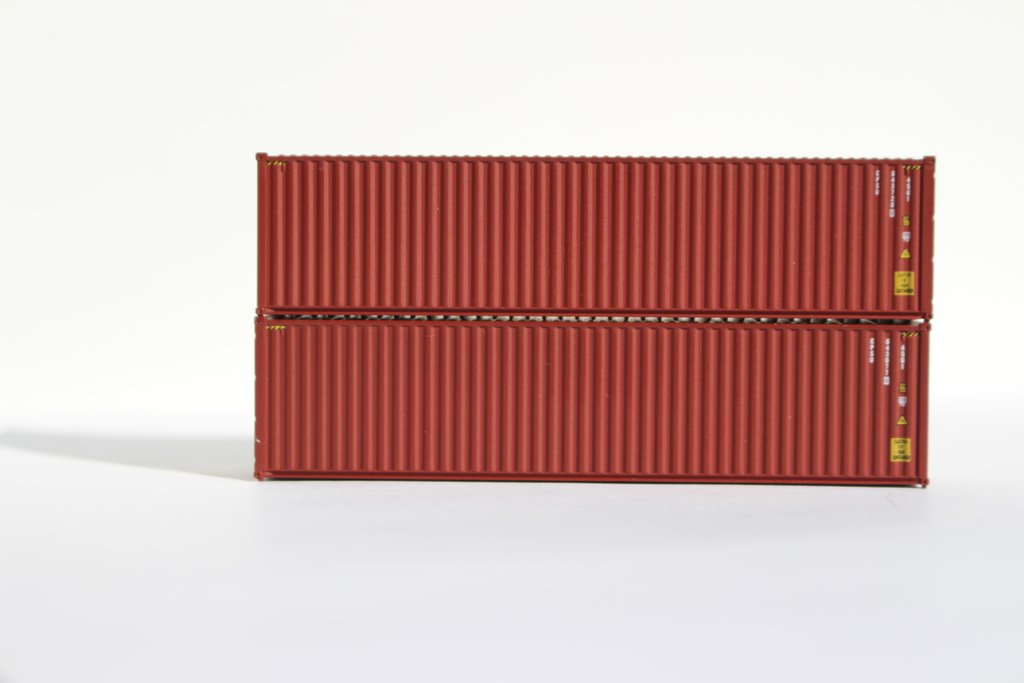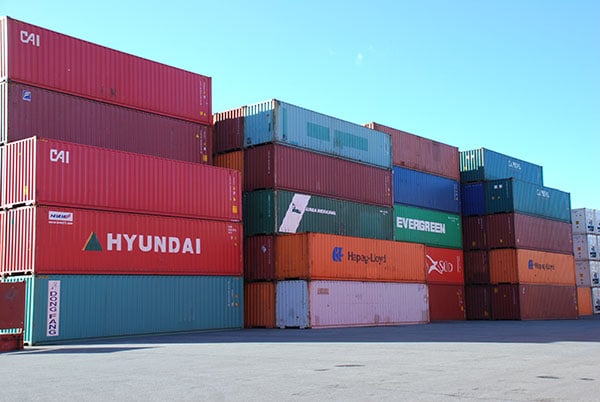Model Information: All New Tooling; -42- corrugated sidesSeven different door variations tooled: molded as appropriate IBC(Inter-Box Connecting pins) in scale ISO locations JTC Magnetic connecting system: 3-magnets bottom & metal top plate Detailed printing as per photographs
Prototype History: The 40 foot container is the king of the container business. It is the most common standard container size used for international and domestic shipping. Most intermodal operations that handle overseas shipping are optimized for this container size. These containers are typically reinforced for loading, unloading and transportation by ship.
Dry containers are meant for non-refrigerated goods and hence are the most common type.
Corrugation in the construction of these containers yields much greater strength (just like with corrugated cardboard for boxes) but is more expensive to fabricate. Due to the extra strength granted by the corrugation, this is a popular type for overseas use.
Dry containers are meant for non-refrigerated goods and hence are the most common type.
Corrugation in the construction of these containers yields much greater strength (just like with corrugated cardboard for boxes) but is more expensive to fabricate. Due to the extra strength granted by the corrugation, this is a popular type for overseas use.
Road Name History:  CP Ships was a large Canadian shipping company established in the 19th century. From the late 1880s until after World War II, the company was Canada's largest operator of Atlantic and Pacific steamships. Many immigrants travelled on CP ships from Europe to Canada. The sinking of the steamship RMS Empress of Ireland was the largest maritime disaster in Canadian history. The company provided Canadian Merchant Navy vessels in World Wars I and II. Twelve vessels were lost due to enemy action in World War II including the largest ship sunk by a German U-boat.
CP Ships was a large Canadian shipping company established in the 19th century. From the late 1880s until after World War II, the company was Canada's largest operator of Atlantic and Pacific steamships. Many immigrants travelled on CP ships from Europe to Canada. The sinking of the steamship RMS Empress of Ireland was the largest maritime disaster in Canadian history. The company provided Canadian Merchant Navy vessels in World Wars I and II. Twelve vessels were lost due to enemy action in World War II including the largest ship sunk by a German U-boat.
The company moved to a model of container shipping from passenger, freight and mail service in the 1960s due to competitive pressure from the airline industry. The company was a part of the Canadian Pacific Ltd. conglomerate. It was spun out as a separate company in 2001. In 2005, it was purchased by TUI AG and is now part of the company's Hapag-Lloyd division.
The Atlantic and Pacific passenger liners of Canadian Pacific were always British-flagged and largely British-manned and were not part of the Canadian Merchant Marine, ownership being with the British-registered Canadian Pacific Steamships Ltd. subsidiary.
From Wikipedia

The company moved to a model of container shipping from passenger, freight and mail service in the 1960s due to competitive pressure from the airline industry. The company was a part of the Canadian Pacific Ltd. conglomerate. It was spun out as a separate company in 2001. In 2005, it was purchased by TUI AG and is now part of the company's Hapag-Lloyd division.
The Atlantic and Pacific passenger liners of Canadian Pacific were always British-flagged and largely British-manned and were not part of the Canadian Merchant Marine, ownership being with the British-registered Canadian Pacific Steamships Ltd. subsidiary.
From Wikipedia
Brand/Importer Information: Now featuring our new line of 1:160 scale models. Developed using the latest in global technology & CAD systems, these New 2017 tooled models feature IBC connecting pins AND our Magnetic connecting system, and are decorated with detailed prototype printing. Our JTC container series of models offer Multiple door styles and variants to match prototypes. The First release is a 'Rib-style' corrugated side Canvas/Open top container, Now In Stock. Our second release is the more common 'wave' corrugation sides version, expected January 2018. Both are New to N scale. Release styles 3 & 4 will be around March 2018, and will be 2 of the most popular container styles in use. Please read our 'Latest News' section for updates. Thank You for visiting. New Facebook page: www.facebook.com/JTCmodeltrains
Item created by: gdm on 2018-07-19 11:49:48. Last edited by CNW400 on 2020-05-14 19:38:14
If you see errors or missing data in this entry, please feel free to log in and edit it. Anyone with a Gmail account can log in instantly.
If you see errors or missing data in this entry, please feel free to log in and edit it. Anyone with a Gmail account can log in instantly.











